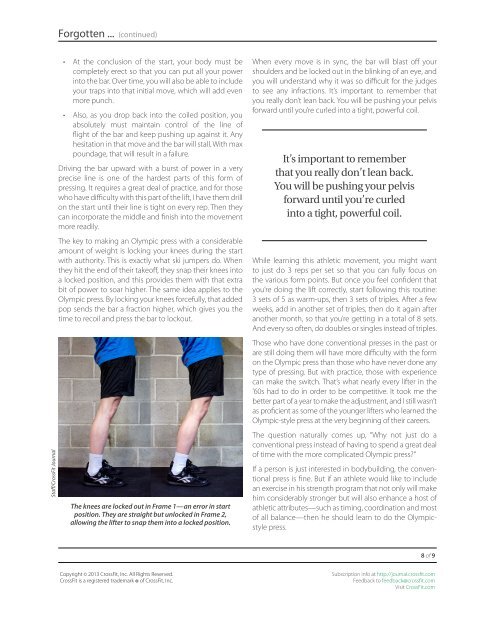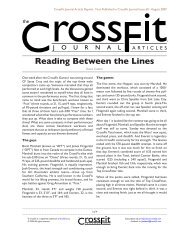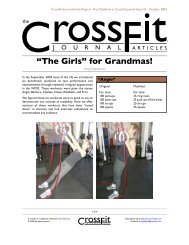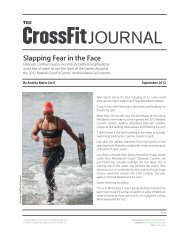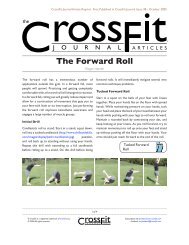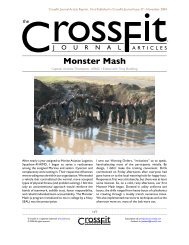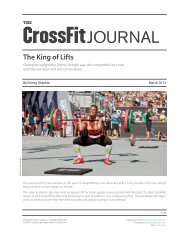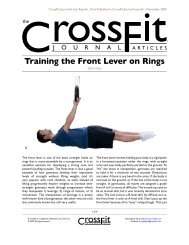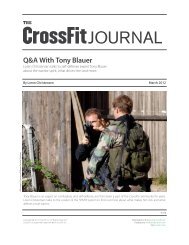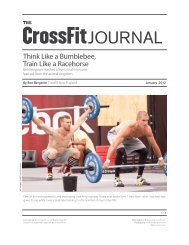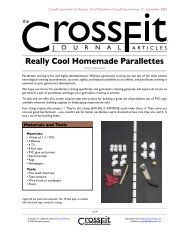JOURNAL - CrossFit
JOURNAL - CrossFit
JOURNAL - CrossFit
You also want an ePaper? Increase the reach of your titles
YUMPU automatically turns print PDFs into web optimized ePapers that Google loves.
Staff/<strong>CrossFit</strong> Journal<br />
Forgotten ... (continued)<br />
• At the conclusion of the start, your body must be<br />
completely erect so that you can put all your power<br />
into the bar. Over time, you will also be able to include<br />
your traps into that initial move, which will add even<br />
more punch.<br />
• Also, as you drop back into the coiled position, you<br />
absolutely must maintain control of the line of<br />
flight of the bar and keep pushing up against it. Any<br />
hesitation in that move and the bar will stall. With max<br />
poundage, that will result in a failure.<br />
Driving the bar upward with a burst of power in a very<br />
precise line is one of the hardest parts of this form of<br />
pressing. It requires a great deal of practice, and for those<br />
who have difficulty with this part of the lift, I have them drill<br />
on the start until their line is tight on every rep. Then they<br />
can incorporate the middle and finish into the movement<br />
more readily.<br />
The key to making an Olympic press with a considerable<br />
amount of weight is locking your knees during the start<br />
with authority. This is exactly what ski jumpers do. When<br />
they hit the end of their takeoff, they snap their knees into<br />
a locked position, and this provides them with that extra<br />
bit of power to soar higher. The same idea applies to the<br />
Olympic press. By locking your knees forcefully, that added<br />
pop sends the bar a fraction higher, which gives you the<br />
time to recoil and press the bar to lockout.<br />
The knees are locked out in Frame 1—an error in start<br />
position. They are straight but unlocked in Frame 2,<br />
allowing the lifter to snap them into a locked position.<br />
Copyright © 2013 <strong>CrossFit</strong>, Inc. All Rights Reserved.<br />
<strong>CrossFit</strong> is a registered trademark ® of <strong>CrossFit</strong>, Inc.<br />
When every move is in sync, the bar will blast off your<br />
shoulders and be locked out in the blinking of an eye, and<br />
you will understand why it was so difficult for the judges<br />
to see any infractions. It’s important to remember that<br />
you really don’t lean back. You will be pushing your pelvis<br />
forward until you’re curled into a tight, powerful coil.<br />
It’s important to remember<br />
that you really don’t lean back.<br />
You will be pushing your pelvis<br />
forward until you’re curled<br />
into a tight, powerful coil.<br />
While learning this athletic movement, you might want<br />
to just do 3 reps per set so that you can fully focus on<br />
the various form points. But once you feel confident that<br />
you’re doing the lift correctly, start following this routine:<br />
3 sets of 5 as warm-ups, then 3 sets of triples. After a few<br />
weeks, add in another set of triples, then do it again after<br />
another month, so that you’re getting in a total of 8 sets.<br />
And every so often, do doubles or singles instead of triples.<br />
Those who have done conventional presses in the past or<br />
are still doing them will have more difficulty with the form<br />
on the Olympic press than those who have never done any<br />
type of pressing. But with practice, those with experience<br />
can make the switch. That’s what nearly every lifter in the<br />
’60s had to do in order to be competitive. It took me the<br />
better part of a year to make the adjustment, and I still wasn’t<br />
as proficient as some of the younger lifters who learned the<br />
Olympic-style press at the very beginning of their careers.<br />
The question naturally comes up, “Why not just do a<br />
conventional press instead of having to spend a great deal<br />
of time with the more complicated Olympic press?”<br />
If a person is just interested in bodybuilding, the conventional<br />
press is fine. But if an athlete would like to include<br />
an exercise in his strength program that not only will make<br />
him considerably stronger but will also enhance a host of<br />
athletic attributes—such as timing, coordination and most<br />
of all balance—then he should learn to do the Olympicstyle<br />
press.<br />
8 of 9<br />
Subscription info at http://journal.crossfit.com<br />
Feedback to feedback@crossfit.com<br />
Visit <strong>CrossFit</strong>.com


